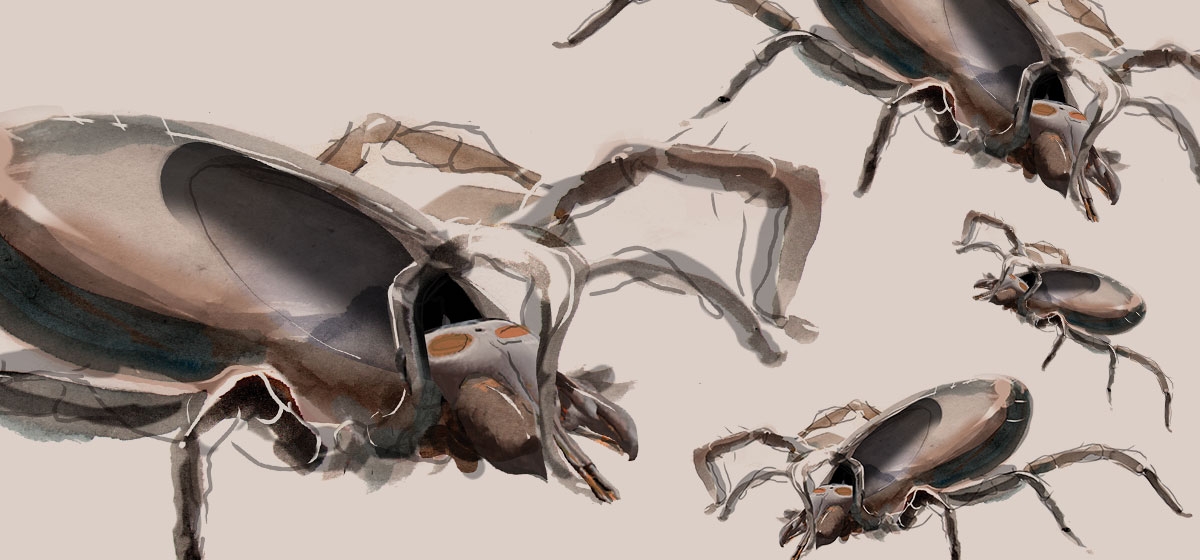Lyme: Pittsburgh’s Growing Epidemic

Ever since her Peace Corps days in Uganda, Libby Ernharth has been fascinated by infectious diseases. In Africa in the 1990s, she first saw the havoc wreaked when parasites and other tiny organisms make their way inside of human hosts.
Later, when she became a physician assistant in Pittsburgh, she dealt mainly with “first-world infections—the consequences of our diets, of our smoking, our chemotherapies and our medications.” For the first decade, rarely part of her practice were diseases passed from ticks to humans, most commonly Lyme.
She remembers clearly the day that all changed.
“About nine years ago, we had a patient in complete heart block (disruption of the heart’s electrical impulses) at St. Margaret’s [UPMC hospital in Aspinwall]. He was an active healthy guy in his 50s but was passing out from a low heart rate. The morning of the procedure, the [heart doctors] consulted us because this patient had a fever. They didn’t want to put hardware (pacemaker) in a guy with a fever.” Ernharth’s physician colleague also noticed that the patient’s face on the left side was drooping: Two clear signs he had contracted an infection caused by the bacterium Borrelia burgdorferi—in other words, Lyme disease from the bite of a tick.
“That’s where it all started. Ever since, during Lyme season, all fevers in our minds are from Lyme until proven otherwise. That’s how endemic we are here,” says Ernharth, who works with a group of physicians at the North Hills private practice, Romano, Pontzer & Associates.
In 2017, Pennsylvania reported the nation’s highest number of confirmed Lyme cases at 9,250, plus another 2,650 probable cases, according to the Centers for Disease Control and Prevention. New Jersey was the next highest state at 3,629 confirmed cases. (Reported cases don’t reflect the true picture as actual incidence is often 10 times higher.)
Lyme takes its biggest toll on the young and middle-aged adults because they’re most likely to be outdoors.
More than 1,500 children each year are treated for Lyme at Children’s Hospital of Pittsburgh of UPMC, according to Dr. Andrew Nowalk, a pediatric infectious disease specialist who’s been researching Lyme since 2003 and has published extensively on the topic. “Lyme is a very, very large load of patients that we’re taking care of. It’s been exponentially growing. There’s not a year since 2002 that we haven’t seen an increase in the number of cases and an increase in the severity of symptoms. We’ve had some children who needed to be in the intensive care unit with life-threatening complications.
“Still, Lyme disease is very, very treatable and children respond much better than adults,” adds Dr. Nowalk, who lives in O’Hara Township and has seen Lyme infect two of his own three children.
The heart-block patient at St. Margaret’s was lucky: His condition was reversed within 24 hours with a course of antibiotics given by IV, Ernharth says. Fortunately, the bacteria that causes Lyme is typically no match for a widely prescribed oral antibiotic that stops the bacteria from growing by binding with one of its proteins. For most people, a few weeks of 100 mg of doxycycline will clear the infection and life goes back to normal. But despite receiving appropriate antibiotic therapy, up to 20 percent of Lyme patients will go on to have lingering symptoms, including fatigue and pain. The CDC calls this post-Lyme disease syndrome (PLDS) and says there is no known cause or cure.
Lyme battle
This is where the Lyme story in Pittsburgh, and other areas facing this epidemic, evolves into one with conflicting branches—one side feels abandoned and misunderstood by conventional medicine. They prefer to call their condition “chronic Lyme” and turn to “Lyme-literate” practitioners, who don’t follow narrow treatment guidelines sanctioned by governing medical bodies such as the Infectious Diseases Society of America (IDSA).
Then there are experts (from the CDC, NIH and other major organizations) warning people that unproven treatments can do more harm than good. A major controversy stems over whether a long course of antibiotics—months or even years, rather than weeks—is needed to cure Lyme disease.
Bill Moore, 49, of Greensburg, has a Lyme story that’s not unusual. In the fall of 2009, he remembers having flu-like symptoms and strange headaches. By 2010, he was chronically tired and developed an allergy to mold. He saw an allergy doctor but his health continued to decline throughout 2011. “I had headaches all the time. My memory was getting bad. It was difficult to think clearly enough to do my job (computer programmer for Giant Eagle). I had high anxiety. I was emotionally unstable and crying all the time. I was getting upset and mad all the time. My stomach hurt all the time. I lost 70 pounds.”
He saw doctor after doctor, including ENT and GI specialists. At some point, he had a Lyme blood test but it came back negative. A colonoscopy showed nothing wrong. He ended up at Cleveland Clinic but to no avail. “By 2012, I was pretty much debilitated,” Moore says. “I was still going to work but it was getting nearly impossible. Out of desperation, I went to a Lyme-literate doctor who tested for spirochete (group of spiral-shaped bacteria that causes Lyme and other diseases) in my urine and I tested positive. He started to treat me with antibiotics and I immediately saw improvement. I continued gradually to improve during a six-month course of antibiotics.”
Moore declined to give his doctor’s name and said only that he’s an internal medicine doctor and among a handful of doctors in the region willing to treat Lyme disease outside of standard guidelines. Moore’s protective nature stems from the fact that doctors from other areas, including New York, have been sanctioned for giving antibiotics to Lyme patients for longer periods of time than the recommended one (or two) 14- to 28-day courses depending on what stage the disease is diagnosed. “These folks that treat Lyme outside of normal medical treatment, we call them Lyme-literate doctors,” Moore says. “We, as a group, are not going to promote them and be the cause of getting them in trouble.”
The group Moore refers to is the Pittsburgh Lyme Disease Support Group (pghlyme.org), part of the PA Lyme Resource Network. Moore leads the local monthly support group and serves as vice president and director of IT for the statewide group. “Our support groups are filling up with people who are not getting the proper care. … Unfortunately, a lot of the standard medical community, doesn’t think it (chronic Lyme) is a big issue.”
In February, Moore led a support group meeting at the Monroeville Senior Center. The guest speaker was an osteopathic medicine doctor who gave a slide presentation about an alternative treatment he uses for his chronic Lyme patients to stem inflammation. The presenter declined to give his name but shared his strong views on the controversy, calling it akin to a “religious war” where people have to demand better treatments the way HIV patients once did. Legislation that would require health insurers to cover long-term treatments for Lyme disease is making its way through the Pennsylvania legislature.
In March, a federal lawsuit, Torrey v. Infectious Diseases Society of America et al., was making its way in a Texas courthouse. A group of 25 patients have sued the IDSA and eight major insurance companies. In summarizing the case, the judge said, “Defendants [as alleged] engaged in a conspiracy to unreasonably restrain trade in the relevant market—the Lyme disease treatment market—by paying large consulting fees to the IDSA panelists to pass the IDSA guidelines which deny the existence of chronic Lyme disease and establish the standard that all Lyme disease is cured with short-term antibiotics.”
The IDSA is reviewing its treatment guidelines and plans to update them by Winter 2020. Currently, the IDSA states, “There is no convincing biologic evidence for the existence of symptomatic chronic B. burgdorferi infection among patients after receipt of recommended treatment regimens for Lyme disease. Antibiotic therapy has not proven to be useful and is not recommended for patients with chronic (greater than or equal to 6 months) subjective symptoms after recommended treatment regimens for Lyme disease.”
Is it really Lyme?
Some doctors believe these patients are simply reporting symptoms commonly seen in the general population or those of a secondary condition such as fibromyalgia or chronic fatigue syndrome. “This assumption lacks proof,” counters Minnesota family practice doctor Elizabeth L. Maloney, in a 2016 article, Controversies in Persistent (Chronic) Lyme Disease, published in the Journal of Infusion Nursing, “given that there are no ‘tests of cure’ for Lyme disease (tests able to prove bacterial eradication) or biomarkers that can identify the presence of PLDS.” The bulk of the evidence, she adds, generally supports the group of physicians who believe that such symptoms are most likely directly attributable to the previous Lyme infection and represent treatment failure.
Providing a glimpse of what life is like for many following a Lyme diagnosis is a published survey of 1,087 people. Dr. Maloney notes, “72 percent rated their health as fair or poor compared with 16 percent of a general population of similar age. They averaged 20 days of poor physical and 15 days of poor mental health per month. Thirty-nine percent had stopped working, and an additional 28 percent had reduced their work hours. Thirty-nine percent had spent at least $5,000 out of pocket for Lyme-related expenses.”
As director of the infectious disease division at Allegheny Health Network, Dr. Nitin Bhanot has seen many Lyme disease patients hospitalized for acute heart and neurological conditions. He also has seen people who blame Lyme for persistent fatigue and attention issues without corroborative test results that support such a diagnosis. They demand more and longer courses of antibiotics. “To prescribe antibiotics for a condition not caused by Lyme disease, or to prescribe longer courses of medication than what is recommended, may do more harm than benefit. We sympathize with patients who have these symptoms, but we adhere to the current guidelines for diagnosis as well as treatment.” Some patients who don’t get treated right away may need to see a rheumatologist for Lyme-induced arthritis, but for others he refers to cognitive behavioral therapy. This doesn’t always go over well, Dr. Bhanot admits. “Some patients will be upset, but a few will say, ‘It’s good you told me that I don’t have Lyme disease.’”
“There is no other disease that people, if after being treated unsuccessfully, are told they are mentally ill,” notes Moore. “Only in Lyme do people that remain sick get told they need a mental health professional or they have now developed an unrelated disease such as fibromyalgia.”
He adds, “They (mainstream medicine) like to say the science is on their side. But I would rebut that and would say the science is strongly unsettled.” Studies show, he adds, that Lyme bacteria in animals can survive after long-term antibiotic treatment and long-term antibiotic therapy can be effective.
“We’ve had some children who needed to be in the intensive care unit with life-threatening complications.”
—Billl Moore
Ernharth is also highly aware of Lyme’s emotional toll. She cried along with a patient recently. This woman had been paying a Lyme-literate doctor far outside of Pittsburgh to treat her chronic fatigue with antibiotics, on and off for five years, and for monthly urine tests. The doctor had convinced her she had chronic Lyme but she wasn’t getting better.
Ernharth explained that no amount of antibiotics was going to cure her, and while she may have felt better while taking antibiotics, it was likely due to a powerful placebo effect and antibiotics’ anti-inflammatory properties. Also, a person can long test positive once exposed to the Lyme-causing bacteria. Ernharth advised the patient that her best options were to consult a functional medicine specialist, who uses herbal and other natural therapies to help stem inflammation that was likely underlying her poor health.
“This woman had so wrapped her heart around a Lyme diagnosis as a reason for feeling tired all of the time, she was in tears. And I cried. But she also came in knowing she was going to hear that. Her gut was telling her that after all of this time, something was not right and she should be feeling better.” Ernharth adds, “People think it’s antibiotics and it’s no big deal. But I’ve lost a patient from C. diff (drug-resistant diarrhea) after one dose of amoxycillin.” She adds, “There is a lot of inflammation caused by this [Lyme] bacteria. And we don’t know what to do about it yet.”
Is functional medicine the answer?
A growing number of people with lingering symptoms following a Lyme diagnosis are turning to functional medicine practitioners that include Pittsburgh-area chiropractors and medical doctors. Learn more about what they can offer and find one at www.ifm.org.
Lyme season
Most cases of Lyme disease are reported from May to August, according to published research by Dr. Andrew Nowalk, a UPMC pediatric infectious disease doctor, who’s been studying Lyme since 2003 and has documented its exponential growth and shift from rural to suburban areas in Southwestern PA. Populations of the tick vector, Ixodes scapularis, have expanded in number and have become increasingly infected with B. burgdorferi (bacteria that causes Lyme). Infected ticks are now detectable in every county in Pennsylvania, with infection rates similar to that of northeastern states where Lyme was first identified in the 1970s after an outbreak of arthritis in children living in Lyme, Connecticut.
Protect your pets and yourself
As a veterinarian at the VCA Fox Chapel Animal Hospital, Amanda Resek was one of the first to see the coming tide of Lyme disease. “It really hit the fan here in 2010. We saw a huge spike in Lyme then. Patient after patient would come in with fever, lack of appetite and joint pain. Most tested positive for Lyme,” she says.
Whenever a physician or pediatrician walked in the door, she warned them to be on the lookout for Lyme in their human patients. Back then, Resek recalls, they weren’t yet seeing it but that would soon change.
Fortunately, Resek has noticed a decline in the rate of symptomatic patients over the past few years. She attributes this to more awareness and a more effective generation of tick-killing products. She highly recommends the Seresto collar or topical K9 Advantix for dogs (and Seresto or Bravecto for outdoor cats). “If we don’t have our patients (pets) on adequate tick control, they are probably bringing ticks into the house,” she says. Even if a pet only steps outside into a tiny backyard, they can get a tick, Resek says, as tick-carrying mice are everywhere.
“The Lyme vaccine’s efficacy isn’t very high so if you have a Seresto collar, you’ll have a better probability that your pet won’t get Lyme,” Resek says. “I have yet to see a Lyme-positive patient with a properly placed Seresto collar.” She uses the Seresto collar on her own dog and cat and likes that its maker, Bayer, has a strong Pittsburgh presence. “We need in every pet to stress a multi-tiered approach,” she adds. “We need preventatives, tick checks, and possibly the vaccine, depending on the risk. We can’t just rely on one entity for prevention of Lyme disease.”




